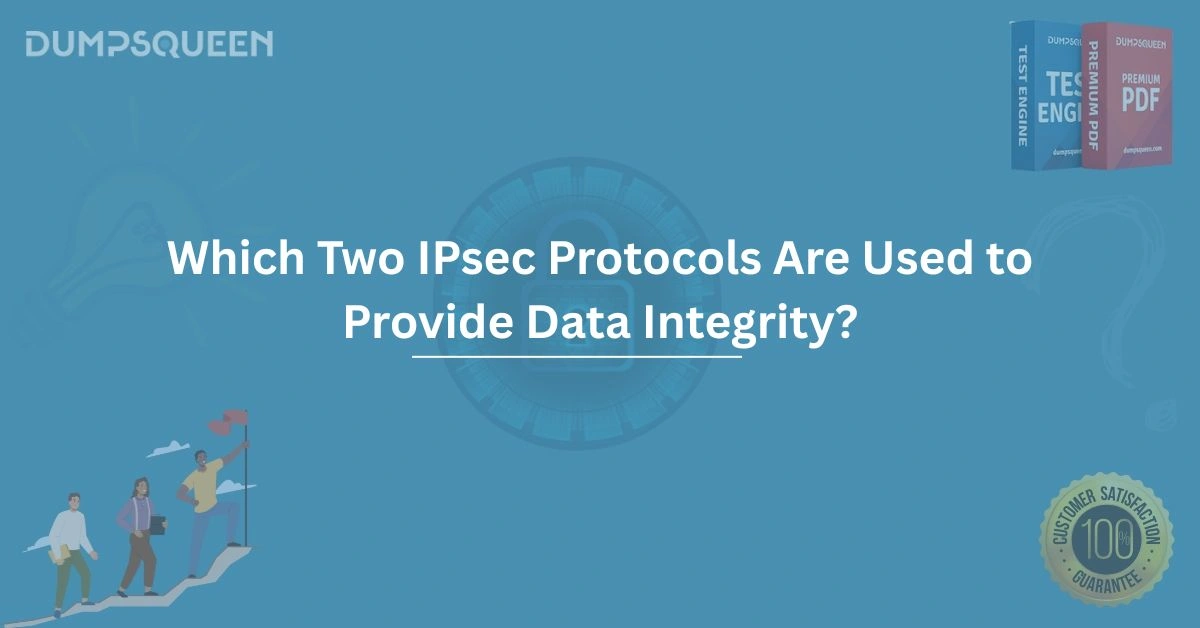Introduction
In the realm of network security, ensuring the integrity of data as it traverses potentially insecure networks is a critical concern for organizations and individuals alike. The Internet Protocol Security (IPSec) suite is a cornerstone of secure communication, offering robust mechanisms to protect data from unauthorized access and tampering. Among its many capabilities, IPSec provides data integrity, ensuring that the information sent from one party to another remains unchanged during transit.
Two key protocols within the IPSec framework are instrumental in achieving this: the Authentication Header (AH) and the Encapsulating Security Payload (ESP). This comprehensive guide, brought to you by DumpsQueen, delves into the intricacies of these protocols, exploring their roles, functionalities, and importance in safeguarding data integrity. Whether you’re preparing for a certification exam or seeking to enhance your cybersecurity knowledge, DumpsQueen is your trusted resource for mastering these concepts.
What is IPSec and Why is Data Integrity Important?
IPSec is a set of protocols designed to secure Internet Protocol (IP) communications by authenticating and encrypting each IP packet in a data stream. It operates at the network layer, providing end-to-end security for data transmitted across networks, including the internet, private networks, and virtual private networks (VPNs). IPSec is widely used in scenarios requiring secure communication, such as remote access, site-to-site VPNs, and secure data transfers.
Data integrity, a core pillar of information security, ensures that data remains accurate and unaltered from its source to its destination. Without data integrity, attackers could modify packets during transmission, leading to unauthorized changes, data corruption, or even malicious code injection. IPSec addresses this concern through mechanisms that verify the authenticity and integrity of data, preventing tampering and ensuring trust in communications. The Authentication Header (AH) and Encapsulating Security Payload (ESP) are the two primary protocols within IPSec that contribute to data integrity, each with distinct features and applications.
The Role of the Authentication Header (AH) in Data Integrity
The Authentication Header (AH) is a protocol within the IPSec suite specifically designed to provide data integrity and authentication for IP packets. Unlike encryption-focused protocols, AH does not encrypt the data payload, meaning it does not provide confidentiality. Instead, it focuses on ensuring that the data has not been altered during transit and verifying the identity of the sender.
How AH Works
AH achieves data integrity by generating a cryptographic hash, also known as an Integrity Check Value (ICV), for each IP packet. This hash is calculated using a shared secret key and a hashing algorithm, such as HMAC-SHA1 or HMAC-MD5. The ICV is included in the AH header, which is inserted between the IP header and the payload of the packet. When the receiving device processes the packet, it recalculates the ICV using the same key and algorithm. If the recalculated ICV matches the one in the AH header, the packet is deemed authentic and unaltered. Any discrepancy indicates that the packet has been tampered with, and it is discarded.
Key Features of AH
AH provides several key features that make it effective for data integrity:
-
Data Origin Authentication: AH verifies the identity of the sender, ensuring that the packet originates from a trusted source.
-
Connectionless Integrity: Each packet is independently authenticated, protecting against modifications regardless of the packet’s position in the data stream.
-
Anti-Replay Protection: AH includes a sequence number in its header, which prevents attackers from reusing captured packets to gain unauthorized access.
AH in Transport and Tunnel Modes
AH can operate in two modes: transport mode and tunnel mode. In transport mode, AH protects the payload of the IP packet while leaving the original IP header intact, making it suitable for host-to-host communication. In tunnel mode, AH encapsulates the entire original IP packet, including the header, within a new IP header. This mode is commonly used in VPNs, where the entire packet needs protection during transit between networks.
Limitations of AH
While AH is highly effective for data integrity, it has limitations. Since it does not provide encryption, the data payload remains visible to anyone intercepting the packet. This lack of confidentiality makes AH unsuitable for scenarios where data privacy is a priority. Additionally, AH’s compatibility with Network Address Translation (NAT) devices can be problematic, as NAT modifies IP headers, which AH authenticates, potentially causing authentication failures.
The Role of Encapsulating Security Payload (ESP) in Data Integrity
The Encapsulating Security Payload (ESP) is another critical protocol within the IPSec suite, offering a more comprehensive set of security services than AH. While ESP is primarily known for providing confidentiality through encryption, it also supports data integrity and authentication, making it a versatile protocol for secure communications.
How ESP Works
ESP ensures data integrity by including an authentication field in its trailer, which contains an ICV similar to that used by AH. This ICV is generated using a cryptographic hash algorithm, such as HMAC-SHA256 or HMAC-MD5, and a shared secret key. Unlike AH, which authenticates the entire IP packet (including the header), ESP authenticates only the encapsulated payload and the ESP header and trailer. This selective authentication makes ESP more compatible with NAT devices, as it does not rely on the integrity of the outer IP header.
In addition to integrity, ESP encrypts the payload, ensuring confidentiality. The encryption process uses symmetric algorithms, such as AES or 3DES, to scramble the data, making it unreadable to unauthorized parties. By combining encryption, integrity, and authentication, ESP provides a robust security solution for a wide range of applications.
Key Features of ESP
ESP offers several features that enhance its effectiveness:
-
Data Confidentiality: Encryption protects the payload from eavesdropping, ensuring privacy.
-
Data Integrity: The ICV verifies that the payload has not been altered during transit.
-
Data Origin Authentication: ESP confirms the identity of the sender, preventing spoofing.
-
Anti-Replay Protection: Like AH, ESP includes sequence numbers to detect and prevent replay attacks.
ESP in Transport and Tunnel Modes
ESP also supports transport and tunnel modes. In transport mode, ESP encrypts and authenticates the payload while preserving the original IP header, suitable for direct host-to-host communication. In tunnel mode, ESP encapsulates the entire original packet within a new IP header, encrypting and authenticating the encapsulated content. This mode is widely used in VPNs, where both confidentiality and integrity are critical.
Advantages of ESP Over AH
ESP’s ability to provide both confidentiality and integrity makes it more versatile than AH. Its compatibility with NAT devices, due to its selective authentication, further enhances its practicality in modern network environments. As a result, ESP is more commonly used than AH in IPSec implementations, particularly in VPNs and other scenarios requiring comprehensive security.
Comparing AH and ESP for Data Integrity
While both AH and ESP provide data integrity, their approaches and applications differ significantly. AH authenticates the entire IP packet, including the header, making it ideal for scenarios where header integrity is crucial. However, its lack of encryption limits its use in environments requiring confidentiality. ESP, on the other hand, authenticates only the payload and ESP-specific headers, offering greater flexibility and compatibility with NAT. Additionally, ESP’s encryption capabilities make it suitable for a broader range of applications.
In practice, ESP is often preferred over AH due to its comprehensive security features. However, AH remains relevant in specific use cases, such as when only authentication and integrity are required, or when encryption is handled by another protocol. Understanding the strengths and limitations of each protocol is essential for designing secure network architectures.
Practical Applications of AH and ESP
AH and ESP are widely used in various network security scenarios, particularly in VPNs and secure remote access solutions. For example, a site-to-site VPN might use ESP in tunnel mode to encrypt and authenticate data transmitted between two corporate offices, ensuring both confidentiality and integrity. Similarly, a remote employee accessing a company network might use ESP to secure their connection, protecting sensitive data from interception.
AH is less common but may be used in environments where data integrity is the primary concern, and confidentiality is not required. For instance, AH could be used in a network monitoring system to ensure that telemetry data is authentic and unaltered without encrypting the content.
Preparing for Certification with DumpsQueen
Understanding the nuances of AH and ESP is crucial for professionals pursuing cybersecurity certifications, such as CompTIA Security+, Cisco CCNA Security, or CISSP. These certifications often include questions on IPSec protocols, testing candidates’ knowledge of their functions, modes, and applications. DumpsQueen, the official website for high-quality study materials, offers comprehensive resources to help you master these concepts. From practice exams to detailed study guides, DumpsQueen equips you with the tools needed to succeed in your certification journey.
Best Practices for Implementing IPSec Protocols
When deploying IPSec with AH or ESP, organizations should follow best practices to maximize security and performance:
-
Choose the Right Protocol: Use ESP for scenarios requiring both confidentiality and integrity, and AH when only integrity and authentication are needed.
-
Select Strong Algorithms: Opt for modern, secure algorithms like AES for encryption and HMAC-SHA256 for hashing to ensure robust protection.
-
Enable Anti-Replay Protection: Always configure sequence numbers to prevent replay attacks.
-
Test NAT Compatibility: If NAT is used in the network, prefer ESP or configure NAT traversal techniques to support AH.
-
Monitor and Update: Regularly update IPSec configurations to address vulnerabilities and ensure compatibility with evolving network requirements.
By adhering to these practices, organizations can leverage AH and ESP to build secure, reliable communication channels.
Conclusion
The Authentication Header (AH) and Encapsulating Security Payload (ESP) are the two IPSec protocols that play a pivotal role in ensuring data integrity within secure communications. AH provides robust authentication and integrity without encryption, making it suitable for specific use cases, while ESP’s comprehensive approach, combining encryption, integrity, and authentication, makes it a versatile choice for modern networks. Understanding the differences, strengths, and applications of these protocols is essential for cybersecurity professionals and organizations aiming to protect their data from tampering and unauthorized access.
DumpsQueen, your trusted partner in cybersecurity education, offers the resources and expertise needed to master these concepts and excel in your certification exams. Whether you’re studying for CompTIA, Cisco, or other certifications, DumpsQueen provides high-quality study materials, practice questions, and expert guidance to help you succeed. Visit DumpsQueen today to take the next step in your cybersecurity journey and gain the knowledge to secure networks with confidence.
Free Sample Questions
-
Which IPSec protocol provides data integrity and authentication but does not encrypt the payload?
a) Encapsulating Security Payload (ESP)
b) Authentication Header (AH)
c) Secure Socket Layer (SSL)
d) Transport Layer Security (TLS)
Answer: b) Authentication Header (AH) -
In which IPSec mode does ESP encapsulate the entire original IP packet within a new IP header?
a) Transport mode
b) Tunnel mode
c) Gateway mode
d) Host mode
Answer: b) Tunnel mode -
Which feature is common to both AH and ESP in IPSec?
a) Data encryption
b) Anti-replay protection
c) Header encryption
d) Payload compression
Answer: b) Anti-replay protection



